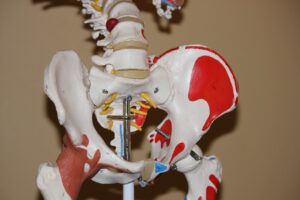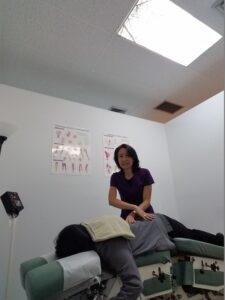
From Dr. Natalie Meiri’s Clinical Pearl Stories:
Chiropractic West Palm Beach: Back Pain From Illiopsoas Syndrome
This is my clinical pearl story about Chiropractic West Palm Beach: Back Pain From Illiopsoas Syndrome. The patient was a 50 year old female patient. Her chief complaint was low back pain. To be HIPAA compliant, I will call her Lilly instead of her real name.
Lilly’s low back pain had come on a week ago. She wasn’t able to straighten up and was bent over. In fact, lying on an exercise ball or in a fetal position in bed with pillows for support helped. Low back pain was an “on going problem” she had dealt with for years. She had gone to physical therapy (P.T.) regularly, but this time she wasn’t getting any relief from P.T.
Lilly had always tried to be active by walking or simple yoga exercises at home. However, recently she had tried interval training. So this entailed running for periods of intense, fast paces followed by less intense recovery. And she thought this may have set off this severe episode of low back pain.
.
Chiropractic West Palm Beach: Back Pain From Illiopsoas Syndrome-
Lilly’s Examination
Upon examination, Lilly tested positive for her low back condition. Lily had strained (strain which occurs when a muscle or tendon is overstretched or torn) her low back. Specifically, she had a severe iliopsoas muscle syndrome.

Anatomy and Function of the Illiopsoas Muscle
Firstly, the iliopsoas muscle complex is made up of three muscles that includes the iliacus, psoas major and psoas minor. It can function as a unit or as separate muscles. The iliopsoas musculotendinous unit is part of the inner muscles of the hip. It is important for correct standing or sitting and for lumbar posture.
Secondly, the iliopsoas muscle primarily flexes the hip and participates in external (outward) rotation of the hip joint. Iliopsoas has an important role in maintaining the strength and integrity of the hip and spine. Unilateral (one sided) contraction of this muscle assists with lateral (away from body) motion of the spine. Bilateral (both sided) contraction elevates the trunk from the supine position (lying down). The psoas can assist extension of the lumbar spine (lowback) while standing.
Thirdly, the psoas major portion of the iliopsoas is located along the sides of the lumbar vertebrae (lowback bones) and intervertebral discs. Below it attaches to the lesser trochanter of the femur (bony protuberance of thigh bone). The iliacus of the the iliopsoas attaches to the upper two-thirds of the iliac fossa (pelvis). Below, it joins the psoas major tendon to the femur near the lesser trochanter.
Symptoms of Iliopsoas Muscle Syndrome
First, the symptoms from dysfunction of the iliopsoas are aggravated by walking, standing or any weight bearing activity. You will feel relief with recumbency (lying down). Additionally, relief is greater when the hip is flexed since this will relax the muscle.
Second, Iliopsoas Muscle Syndrome is said to be as painful as appendicitis when very acute.
Third, the muscle can cause a painful compression/entrapment syndrome of the femoral nerve (large nerve in the front of the thigh that controls the muscles and sensation in the lower limbs).
Forth, unidentified iliopsoas and/or low back muscle dysfunctions are frequently responsible for a failed low back postsurgical syndrome.

Chiropractic West Palm Beach: Back Pain From Illiopsoas Syndrome-
Lilly’s Treatment and Outcome
Treatment focused on restoring normal mobility to the low back and pelvis. These treatments at Meiri Chiropractic included:
-Chiropractic manipulative therapy- to the spinal joints and associated regions (e.g. hip, pelvis).
-Gentle myofascial release and/or post isometric relaxation techniques- to the soft tissues (e.g. iliopsoas muscles, tendons, fascia) involved.
-Electric Muscle Stimulation, Ice and Heat Therapies for pain relief and inflammation reduction.
-Therapeutic exercise- with gentle stretching and a long-term goal of restrengthening of the Illiopsoas was recommended.
-Finally, recommendations for prevention of further injury for the spine and pelvis.
Lilly felt better even after the first visit and within 12 visits was pain-free and functioning fully. Moreover, Lily’s posture was restored and improved. Thereafter, she came in for other injuries or for supportive care/maintenance of her spine and the Illiopsoas muscle.
Are you suffering from Illiopsoas Muscle Syndrome? Dr. Natalie Meiri can definitely help you. Call 561-253-8984 today for an appointment or to find out more about Chiropractic West Palm Beach: Back Pain From Illiopsoas Syndrome.
References:
Thomas Bergman, David Peterson, Chiropractic Technique Principles and Procedures, 3rd edition, 2011
Janet Travel and David Simon, Myofascial Pain and Dysfunction, 1997